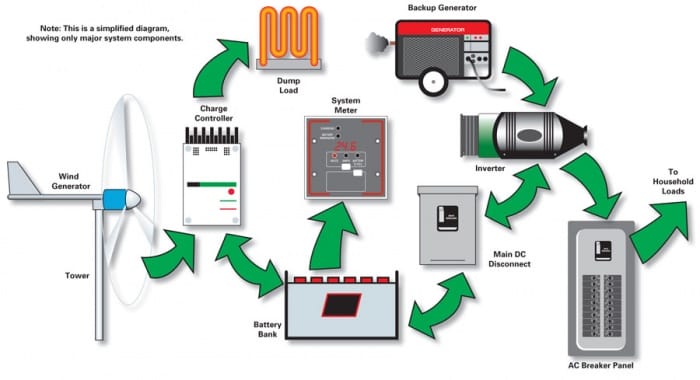What is Wind Electricity?
Wind energy is a dynamic if invisible resource—the energy available in a moving mass of air. From grain grinding by simple wind-driven machines in ancient cultures to modern electricity-generating devices, the wind has been tapped to work for us.
Wind is a cubic energy resource. As the wind speed increases, the power available increases cubically. This means that it’s very important to get into higher wind speeds, and the way we do that is with taller towers. Regardless of the turbine or tower type, going higher is the tried-and-true, reliable way to increase performance in a wind generator. And the most common mistake in wind electricity is installing a turbine on a short tower.
The swept area of a wind turbine is the second most important factor (after the wind resource itself) that determines energy production. The circle “swept” by the blades is the collector area. It’s not possible to get a large amount of energy out of a small collector area. Betz’ theorem says we can only get about 60% of the energy out of the wind before we start slowing it down too much and actually decreasing performance. In the real world, well-designed machines can achieve about half of that.
Turbines can be divided by orientation, directionality, generating mode, and by other characteristics. Horizontal-axis wind turbines (HAWTs) are the most common and effective orientation. Vertical-axis wind turbines (VAWTs) may appeal to the uninitiated, but continue to disappoint as far as performance and longevity—both of the machines and the companies. Upwind (the wind hits the turbine before it hits the tower) and downwind (the wind hits the tower before it hits the turbine) designs can both be very effective.
Generating devices generally fall into one of three categories. Most home-scale turbines use permanent magnet generators (PMGs), which typically have fixed coils of copper wire and rotating groups of magnets that pass by them. Some older machines use wound-field alternators, which use a small amount of the wind energy to create electro-magnetism in the rotating part of the alternator. Induction motor/generators use conventional induction motors, but have the wind push them beyond their normal operating speed, which takes them from using electricity to making electricity.
Three basic tower types are used for residential wind-electric systems. Freestanding towers are the most expensive, but can be installed in very close quarters, and are perhaps the safest to install and maintain. Tilt-up towers allow all maintenance and repair to be done on the ground, but require a large open area for installation and use. Fixed-guyed towers include lattice and pole styles that do not tilt, and must be climbed for installation and service. These are typically the least costly, and need a moderate area for installation.
A wind-electric system is much more than just the wind generator and tower. Also required are transmission wiring, electronic controls, batteries if storage or backup is desired, an inverter for household AC or grid-interconnect, as well as metering, overcurrent protection, and other standard electrical components. All appropriate components should be chosen for compatibility and functionality—it takes a whole system to make wind electricity.
Why Use Wind Power?
People choose to use wind energy for a variety of reasons, including perhaps the most important one—they want to! More specific motivations include environmental, financial, independence, reliability, and social.
Energy and our energy choices have a huge impact on our physical environment. More than half of the electricity used in the United States is generated by burning coal. This coal is sourced by strip mining, pit mining, shaft mining, and mountaintop removal. All of these methods of extraction, and the burning of coal, have a deleterious effect on the ground, water, and air, not to mention the health of workers and nearby residents. Other major sources of electricity nationally are natural gas and nuclear energy, both of which have environmental damage and risk involved in fuel extraction and use.
While all energy producing endeavors have an impact, wind energy (as well as other renewables) have a lower impact overall, if well designed and implemented. There is embodied energy in wind-electric systems, but the fuel is free and recurs daily, and the ongoing impacts on the environment are negligible.
Wind-electric systems can also be of financial benefit, depending on the situation. Off-grid system owners regularly see that having wind electricity in the windy season is more cost effective than utility line extension or increased generator usage. If you live on-grid, you will need a combination of a good wind resource, high utility rates, and decent incentives to compete with subsidized dirty energy.
Our country was founded on independence, and there is a strong independent streak that runs through America even today, especially in rural environments. While people value working together and helping each other, they don’t like the dependence on governments, utilities, or charity—they want to take care of themselves. Having a wind-electric system can fulfill this motivation, regaining control of energy generation and bills.
Some wind-electric system owners primarily want reliability. These systems—especially hybrid systems with solar-electric arrays and batteries—can provide very reliable electricity, more reliable than the utilities in many cases. On a personal level, this can allow people with medical conditions, businesses with critical loads, and public service organizations to continue functioning during storms and utility outages. Looking at the situation from another perspective, grid-tied wind-electric systems contribute to the stability of the utility grid, not only supplying the owners with electricity, but sharing their surplus with their neighbors via the grid.
Last and not least, many people want to use wind electricity because, “it’s cool!” When you think about it, many if not most of the buying decisions we make are not based strictly on dollars or “sense,” but on our own personal preferences, our own need for fun, status, beauty, and interest. Having a wind generator over your home brings all of that and more, and is a strong statement of your individuality, your values, and your forward thinking.
How to Use Wind Power
Four basic types of wind-electric systems are possible, and three are common. Perhaps the simplest type is wind-electric water pumping, which couples a wind generator to an electric pump, usually via electronics. This may be a viable system type when remote water pumping is needed in a windy area. But few if any complete system packages are available for this application, and the need is most often served with wind-mechanical (water-pumping windmill) equipment and solar-electric systems. Direct heating systems are also possible, but typically end users want to do more with their systems than solely heat, and also don’t need heat year-round, so the energy is less useful.
An off-grid wind-electric system uses batteries, and often includes a solar-electric array and back-up generator. These systems must provide all the electrical energy, since utility electricity is not available or desired. This means that they will produce significantly more energy than is used, because they need to keep a battery bank charged, and because there will be times of excess wind where the surplus cannot be used.
A Battery-based grid-tie system is configured very similarly to an off-grid system, but also has a grid connection, and the ability to “sell” surplus energy to the local utility. These systems have the advantage, because of the battery bank, of providing limited backup during utility outages. Wind-electric back-up systems often function quite well because many utility outages are caused by storm, when wind is abundant.
Batteryless grid-tie wind-electric systems are the least costly, most efficient, and most environmentally friendly systems because they avoid the use of batteries, and they tend to operate at higher voltage. They produce grid-compatible electricity to feed house loads and to sell back to the utility, making full use of all energy generated. Their sole drawback is that they cannot operate during utility outages, and therefore provide no back-up protection.
Wind electricity can power most electrical loads, depending on the size of the wind generator and the wind resource available. Direct water pumping and heating systems are dedicated to specific loads. Most systems provide electricity for a variety of purposes, including lighting, home appliances, office equipment, and more. Home-scale and small wind generators are also used on boats, navigation equipment, remote communications sites, businesses, and other facilities. If you have an abundant wind resource, you may be able to not only run your lighting and appliance loads, but also heat your home, either through direct electrical heat or by running a heat pump. This is often a good match because wind tends to rob heat from homes, and the windy season often coincides with the heating season.
Get Started with Wind Power
Wind-electric systems are the hardest renewable energy system to install and maintain, with the highest danger, and the highest failure rate. While die-hard do-it-yourselfers may take this on as a challenge, most people will be better served hiring or at least working with a wind energy professional to design, install, and maintain a reliable, long-term system.
The first step in the process is to assess your site and yourself, to determine whether you have a good wind resource, a good site, and a good situation for a wind-electric system. Site analysis takes experience, expertise, and “feel”—most people overestimate their wind resource, and underestimate the cost and difficulty of capturing it. Professional wind smiths draw on mapping, weather data, and local experience to determine where best to site a wind generator on your property, how tall to make the tower, and what to expect as far as performance.
A common incentive to pursue wind energy is that it’s fun and satisfying. Often, it’s difficult to make a strong financial case for home-scale systems, and the smaller they are, the harder it is. When a combination of a great resource (more than 12 mph average), high utility rates, and reasonable incentives are present, you may be able to satisfy your subjective motivations and your financial goals.
When estimating the cost of a wind-electric system, make sure you look at the complete system. The wind turbine is only one part of the package, and rarely the most expensive part. You need tower and foundation, transmission equipment, electronics, metering, and more to make a working system. Also make sure you have a generous line item in your long-term budget for ongoing maintenance. Without this vital attention, your investment will be unlikely to last for the long haul.
While it’s attractive to consider a dynamic wind turbine high above your home, making some or all of your electricity, it’s best to approach such a project with clear priorities and open eyes. First and foremost, remember that energy efficiency will be a better buy—both for your pocket book and the environment—than a wind-electric system. First do the work of paring down your energy load, by purchasing the most efficient appliances you can buy, and using energy wisely throughout your home.
Avoid the common pitfalls of wind energy:
- Make sure you know what your wind resource (average wind speed) is, and that it’s adequate to the task.
- Understand what you will get out (in kWh per year) from any wind turbine you are considering
- Buy a large enough wind turbine; the swept area is the collector, and you won’t get a lot out of a little collector
- Install your wind turbine on a tall tower —well above all nearby obstructions. Short towers and roof mounting are bad ideas that you’ll be disappointed in.
- Perform regular maintenance—at least once a year—to help your wind generator last, and provide you with electricity for years.
credit: http://www.homepower.com/articles/wind-power/basics/get-started-wind-power

